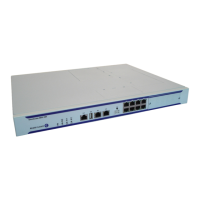Interface Configuration
7750 SR OS Interface Configuration Guide Page 57
Configuring MC-MLPPP QoS Parameters
A 4-class MLPPP bundle can be configured with user-defined MLPPP QoS attributes. This
feature cannot be used with MC-MLPPP bundles with fewer than 4 classes or with non-multiclass
bundles.
The following describe the parameters and the configuration processes and rules
1. The user creates an ingress QoS profile in the mlppp-profile-ingress context, to
configure a preferred value of the ingress per-class re-assembly timer. Ingress QoS
profile 1 is reserved for the pre-defined profile with parameter values displayed in
Table 11. The user is allowed to edit this profile and change parameter values. When a
user creates a profile with a profile-id greater than 1, or performs the no option command
on the parameter, the parameter's default value will always be the 1 in Table 11 for
ingress QoS Profile #1 regardless of the parameter value the edited Profile 1 has at that
point
2. The user creates an egress QoS profile in the mlppp-profile-egress context to configure
preferred values for the per-class queue and queue scheduling parameters. The user can
also configure system forwarding class mapping to the MLPPP classes. Egress QoS
profiles 1, 2, and 3, are reserved for the pre-defined profiles with parameter values shown
in Table 8, Table 9, or Table 10. Users can edit these profiles and change parameter
values. When a user creates a profile with a profile-id higher than 3, or when the user
specifies the no option command on the parameter, the default value will be the one
shown in Table 8, Table 9, or Table 10 for the egress QoS Profile 1. This is regardless of
the parameter value the edited profiles have at that point in time.
3. A maximum of 128 ingress and 128 egress QoS profiles can be created on the system.
4. The values of the ingress per-class re-assembly timer are configured in the ingress QoS
profile.
5. The mapping of the system forwarding classes to the MLPPP Classes are configured in
the egress QoS profile. There is a many-to-one relationship between the system FC and
an MLPPP class. See Table 8 for the mapping when one of the three pre-defined 4-class
egress QoS profiles is selected.
6. The maximum size for each MLPPP class queue in units of msec at the available bundle
rate is configured in the egress QoS profile. This is referred to as max in Figure 6 and as
max-queue-size in CLI. The out-of-profile threshold for an MLPPP class queue, referred
to as oop in Figure 6, is not directly configurable and is set to 50% of the maximum
queue size rounded up to the nearest higher integer value.
7. The MLPPP class queue scheduling parameters is configured in the egress QoS profile.
The minimum information rate, referred to as MIR in Figure 7 and mir in CLI, applies to
Class 1 queue only. The MIR parameter value is entered as a percentage of the available
bundle rate. The WRR weight, referred to as W1, W2, and W3 in Figure 7
and weight in
CLI, applies to class 1, class 2, and class 3 queues. Note that W1 in Figure 7 is not
configurable and is internally set to a value of 1 such that Class 1 queue shares 1% of the
available bundle rate when the sum of W1, W2, and W3 equals 100. W2 and W3 weights
are integer values and are user configurable such that Class 2 queue shares (W2/(W1 +

